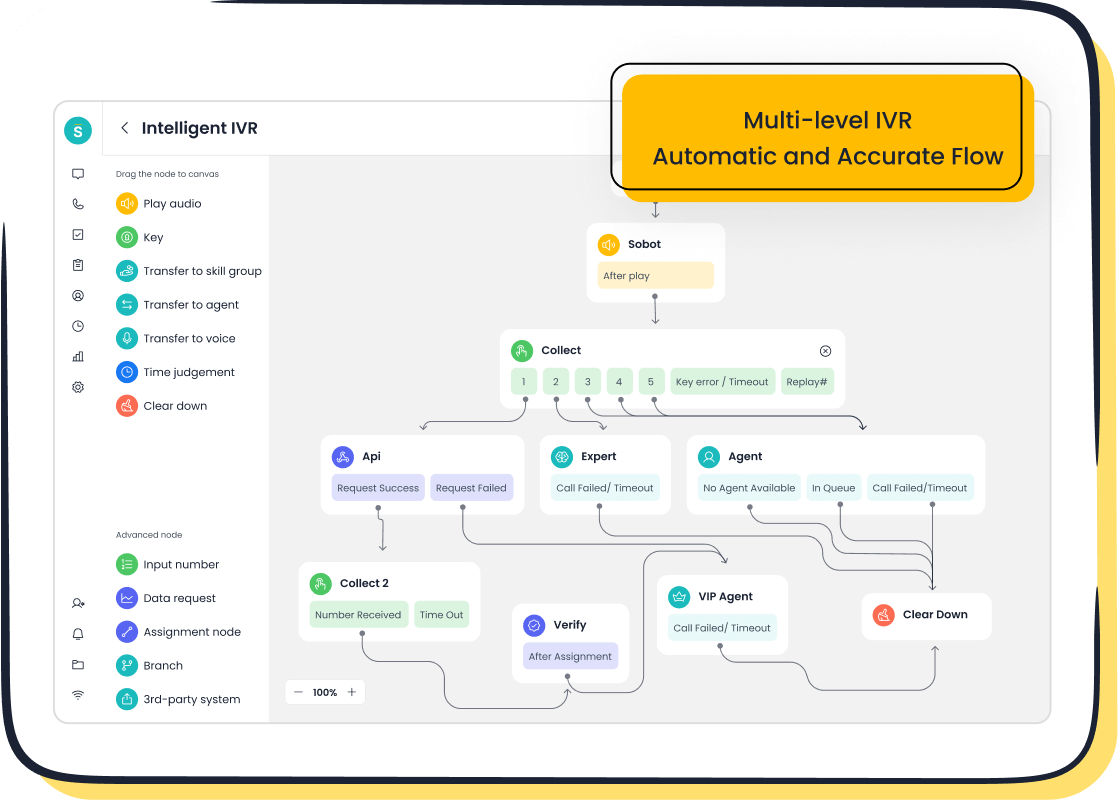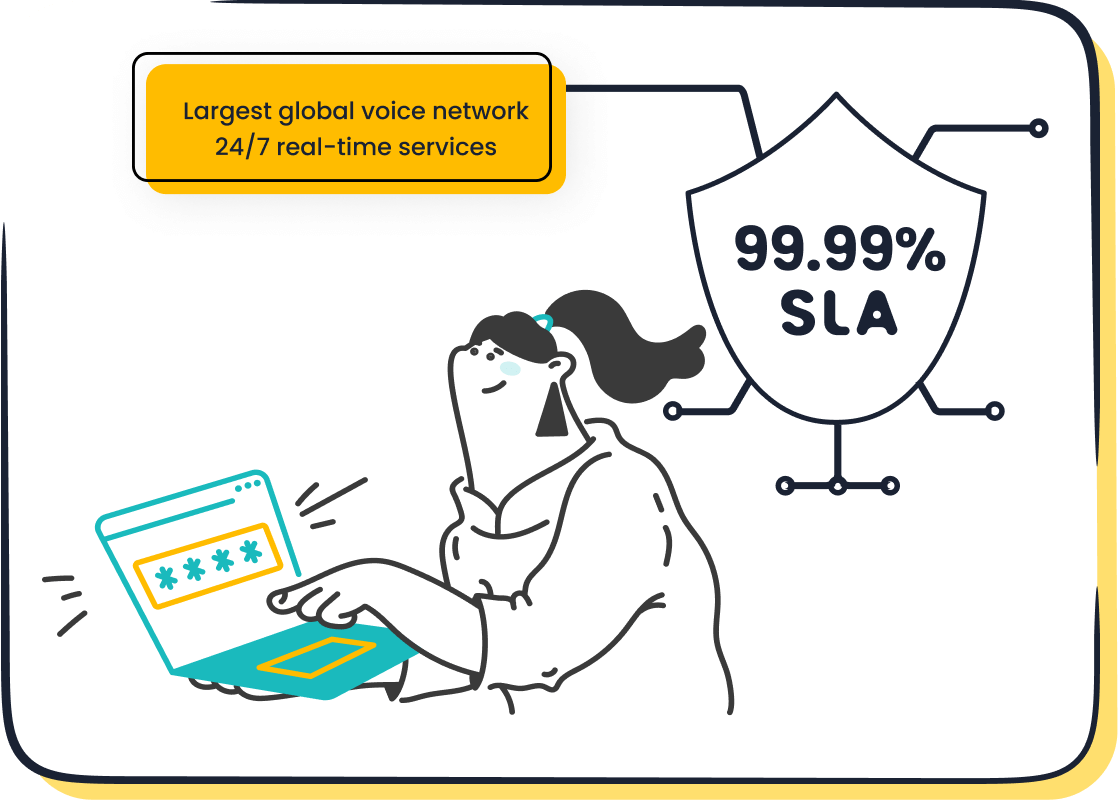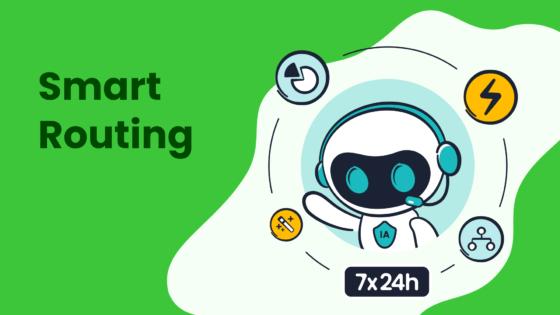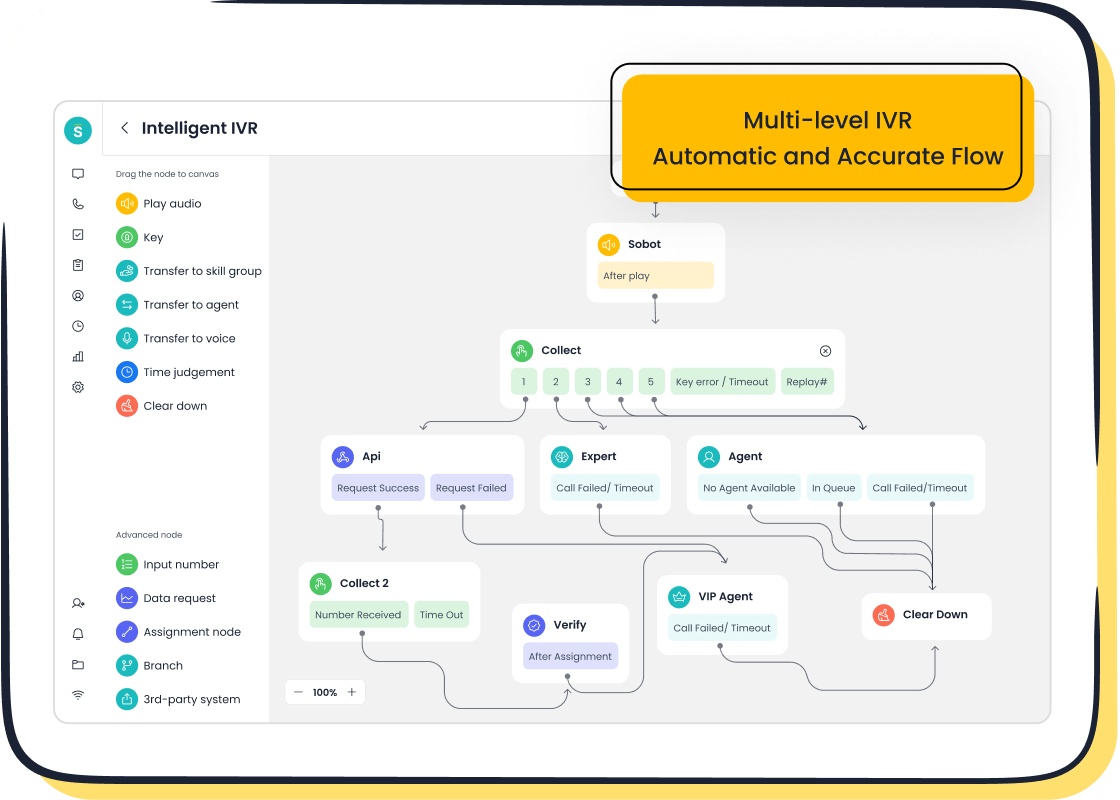Contact Center Analytics Explained: Boost Your Performance

Contact centre analytics utilizes data-driven tools to monitor, analyze, and enhance customer interactions and operational workflows. It provides valuable insights into customer preferences, streamlines processes, and elevates service quality. Businesses leveraging analytics have achieved impressive outcomes, such as a 40% reduction in average handle time and nearly a 50% increase in service-to-sales conversion rates. In 2024, 52% of contact centers reported adopting marketing analytics to drive engagement, while 44% implemented speech analytics for real-time insights. Sobot's Voice/Call Center platform simplifies this journey, offering advanced AI-powered tools to optimize customer experience and operational efficiency.
What Is Contact Center Analytics?
Definition and Importance
Call center analytics refers to the process of collecting, analyzing, and interpreting data from customer interactions to improve service quality and operational efficiency. It helps you understand patterns in customer behavior, identify areas for improvement, and make data-driven decisions. By leveraging analytics, businesses can achieve faster issue resolution, better first call resolution rates, and more personalized service.
The industry is experiencing rapid growth, with the contact center analytics market projected to grow at a compound annual growth rate of 19.7% from 2023 to 2030, reaching USD 5.75 billion by 2030. This growth reflects the increasing demand for tools that enhance customer satisfaction and agent performance. Key benchmarks include knowledgeable agents, seamless self-service options, and the ability to resolve issues quickly.
Role in Enhancing Customer Experience
Call center analytics plays a pivotal role in transforming the customer journey. It enables you to track and analyze every interaction, from the first inquiry to issue resolution. This data helps you identify pain points and optimize processes to deliver a seamless experience. For example, sentiment analysis can reveal how customers feel during calls, allowing you to adjust your approach in real time.
By integrating multiple communication channels, analytics ensures that customers receive consistent service, whether they contact you via phone, email, or chat. This omnichannel approach not only improves satisfaction but also builds trust and loyalty. Businesses using analytics often report higher customer satisfaction scores and reduced call abandonment rates, directly impacting their bottom line.

How Sobot's Voice/Call Center Supports Analytics
Sobot's Voice/Call Center takes call center analytics to the next level. Its advanced features, such as real-time monitoring and AI-powered voicebots, provide actionable insights into customer interactions. The platform's intelligent IVR system routes calls efficiently, reducing wait times and improving first call resolution rates.
With tools like call tracking and data analytics, you can measure key metrics such as average handle time and customer satisfaction. The unified workspace consolidates customer data, enabling agents to deliver personalized service. Additionally, Sobot's global network and 99.99% system uptime ensure reliable performance, even during peak hours.
Sobot's solutions empower you to enhance the customer journey by providing a stable, scalable, and secure platform. Whether you're a small business or a large enterprise, Sobot's analytics tools help you make informed decisions, improve agent productivity, and elevate the overall customer experience.
Types of Contact Center Analytics
Speech Analytics
Speech analytics focuses on analyzing spoken conversations to uncover valuable insights. It uses advanced technologies like generative AI to process and interpret voice data quickly. This type of call center analytics helps you identify patterns in customer interactions, such as common complaints or frequently asked questions. By doing so, you can address recurring issues and improve service quality.
Real-time speech analytics takes this a step further by analyzing conversations as they happen. For example, if a customer sounds frustrated during a call, the system can alert agents to adjust their tone or offer immediate solutions. This proactive approach enhances customer satisfaction and reduces the likelihood of escalations.

Sobot's Voice/Call Center leverages speech analytics to provide a unified view of customer interactions across channels. Its AI-powered voicebots and real-time monitoring tools ensure that you can act on insights instantly, improving both efficiency and customer experience.
Text Analytics
Text analytics examines written communication, such as emails, chat messages, and social media posts. It helps you understand customer sentiment and identify trends in feedback. For instance, if multiple customers mention a specific issue in their messages, text analytics can flag it for immediate attention.
This type of call center analytics is particularly useful for monitoring sentiment trends. Positive feedback can highlight what your team is doing well, while negative comments can pinpoint areas for improvement. Businesses often use text analytics to enhance their products or services based on customer input.

Sobot's unified workspace integrates text analytics seamlessly, allowing agents to access and analyze customer messages from various channels in one place. This feature not only saves time but also ensures a consistent and personalized customer experience.
Predictive Analytics
Predictive analytics uses historical data to forecast future trends and behaviors. In a call center, this means you can anticipate customer needs and prepare your team accordingly. For example, if data shows a spike in inquiries during a specific season, you can schedule more agents to handle the increased volume.
This type of call center analytics also helps you identify at-risk customers who may leave your service. By addressing their concerns proactively, you can improve retention rates and build long-term loyalty. Predictive analytics empowers you to make informed decisions that benefit both your customers and your business.

Sobot's analytics tools include predictive capabilities that help you stay ahead of customer demands. With features like call tracking and data analysis, you can optimize your operations and deliver exceptional service every time.
Real-Time Analytics
Real-time analytics allows you to analyze customer interactions as they happen. This capability provides immediate feedback, enabling you to make quick adjustments and improve outcomes. For example, if a customer expresses frustration during a call, real-time monitoring can alert agents to address the issue promptly. This proactive approach reduces escalations and enhances customer satisfaction.
Real-time insights also help you optimize operational efficiency. You can monitor call volumes, agent performance, and customer sentiment in real time. This data enables you to allocate resources effectively and maintain service quality during peak hours. For instance, if call volumes spike unexpectedly, you can quickly deploy additional agents to handle the load.

Sobot's Voice/Call Center excels in real-time analytics. Its real-time monitoring tools track key metrics like average handle time and first call resolution. The platform's AI-powered voicebots analyze conversations instantly, providing actionable insights to agents. These features ensure that you can deliver exceptional service, even in high-pressure situations.
Sentiment Analysis
Sentiment analysis focuses on understanding customer emotions during interactions. It uses advanced algorithms to analyze tone, word choice, and context. This analysis helps you gauge customer satisfaction and identify areas for improvement. For example, if sentiment analysis reveals a pattern of negative feedback about a specific product, you can address the issue proactively.
This tool also enhances personalization. By understanding a customer's emotional state, agents can tailor their responses to build rapport and trust. Positive interactions increase customer loyalty and improve overall satisfaction.
Sobot's analytics tools include sentiment analysis capabilities. The platform integrates this feature across all communication channels, from voice calls to chat messages. This unified approach ensures consistent service and helps you identify trends in customer sentiment. By leveraging these insights, you can refine your strategies and deliver a superior customer experience.
Key Call Center Performance Metrics to Track

Tracking the right call center performance metrics is essential for improving operational efficiency and delivering a superior customer experience. These metrics, often referred to as KPIs, provide actionable insights into your team's performance and help you identify areas for improvement. Let’s explore three key performance indicators that can transform your contact center operations.
Average Handle Time (AHT)
Average Handle Time (AHT) measures the average duration of a customer interaction, including talk time, hold time, and after-call work. This metric is crucial for assessing efficiency and identifying bottlenecks in your processes. A lower AHT often indicates streamlined workflows and well-trained agents, while a higher AHT may signal the need for additional training or process optimization.
Tip: Reducing AHT doesn’t mean rushing through calls. Focus on resolving issues effectively while maintaining a positive customer experience.

For example, Sobot's Voice/Call Center platform offers tools like intelligent IVR and AI-powered voicebots to reduce AHT by routing calls efficiently and automating repetitive tasks. These features allow agents to focus on resolving complex issues, ultimately improving both efficiency and customer satisfaction.
| Metric | Impact on Performance |
|---|---|
| Average Handle Time | Helps set benchmarks and identify areas for improvement |
Tracking AHT helps you set performance benchmarks and analyze trends over time. It also highlights agents who may need additional support, ensuring consistent service quality across your team.
Customer Satisfaction Score (CSAT)
Customer Satisfaction Score (CSAT) is one of the most widely used customer experience metrics. It measures how satisfied customers are with their interactions, typically through post-interaction surveys. A high CSAT score reflects excellent service quality, while a low score indicates areas that need attention.
Most call centers aim for a CSAT score of 85% or higher. This benchmark serves as a reliable indicator of your team's ability to meet customer expectations. For instance, Sobot's analytics tools enable you to monitor customer satisfaction scores in real time, providing insights that help you refine your strategies and improve service delivery.
- Why CSAT Matters:
- Direct feedback from surveys reveals customer sentiment.
- High scores correlate with increased loyalty and repeat business.
- Low scores highlight pain points in the customer journey.
By integrating CSAT tracking into your performance metrics, you can make data-driven decisions to enhance the overall customer experience.
First Call Resolution (FCR)
First Call Resolution (FCR) measures the percentage of customer issues resolved during the first interaction. This metric is a cornerstone of call center analytics because it directly impacts customer satisfaction and operational efficiency. Resolving issues on the first call reduces the need for follow-ups, saving time for both customers and agents.
For example, Sobot's unified workspace consolidates customer data, enabling agents to access all relevant information during the first interaction. This feature improves FCR rates by equipping agents with the tools they need to resolve issues quickly and effectively.
- Benefits of High FCR:
- Enhances customer satisfaction by minimizing repeat calls.
- Reduces operational costs associated with follow-ups.
- Builds trust and loyalty by demonstrating efficiency.
FCR is not just a metric; it’s a reflection of your team's ability to deliver a seamless customer journey. By prioritizing this KPI, you can improve both customer satisfaction and agent productivity.
Net Promoter Score (NPS)
Net Promoter Score (NPS) measures customer loyalty by asking a simple question: "How likely are you to recommend our service to others?" Customers respond on a scale of 0 to 10, where 9-10 are promoters, 7-8 are passives, and 0-6 are detractors. The NPS is calculated by subtracting the percentage of detractors from the percentage of promoters. This metric provides a clear picture of how satisfied and loyal your customers are.
NPS is one of the most critical call center performance metrics. It helps you understand how well your service meets customer expectations. A high NPS indicates strong customer satisfaction and loyalty, while a low score signals areas needing improvement. For example, companies with an NPS above 50 are considered industry leaders, while those below 0 need immediate action.
Sobot's Voice/Call Center platform supports NPS tracking by providing tools to gather and analyze customer feedback. Its unified workspace consolidates customer data, making it easier for agents to deliver personalized service. By improving first call resolution and reducing average handle time, Sobot helps you boost customer satisfaction scores and, ultimately, your NPS.
Tip: Regularly monitor your NPS to identify trends and take proactive steps to improve customer loyalty. Use insights from call center analytics to address pain points and enhance the overall customer experience.
Call Abandonment Rate
Call abandonment rate measures the percentage of calls disconnected by customers before speaking to an agent. This metric is a vital indicator of call quality metrics and operational efficiency. A high abandonment rate often points to long wait times or inefficient call routing, which can negatively impact customer satisfaction.
For example, if your call abandonment rate exceeds 5%, it may indicate that customers are frustrated with delays. Addressing this issue can significantly improve customer retention and satisfaction. Businesses that optimize their call center analytics often achieve lower abandonment rates by identifying bottlenecks and streamlining workflows.
Sobot's intelligent IVR and smart call routing features help reduce abandonment rates. The platform ensures that calls are directed to the right agents quickly, minimizing wait times. Additionally, real-time analytics enable you to monitor call volumes and adjust staffing levels as needed. These tools empower you to maintain high service standards, even during peak hours.
Note: Reducing call abandonment rates not only improves customer satisfaction but also enhances your team's efficiency. Focus on optimizing key performance indicators like average handle time and first call resolution to achieve better results.
Benefits of Using Contact Center Analytics

Improving Customer Experience with Sobot
Call center analytics plays a vital role in enhancing the customer journey. By analyzing customer interactions, you can identify pain points and optimize processes to deliver a seamless experience. For instance, sentiment analysis helps you understand how customers feel during calls, enabling you to adjust your approach in real time. This proactive strategy improves customer satisfaction and builds trust.
Sobot's Voice/Call Center platform empowers you to elevate the customer experience. Its intelligent IVR system ensures calls are routed efficiently, reducing wait times. Real-time monitoring tools provide actionable insights, allowing you to address issues promptly. Additionally, the platform's unified workspace consolidates customer data analytics, enabling agents to deliver personalized service. These features help you achieve higher customer satisfaction scores and foster loyalty.
| Metric | Description |
|---|---|
| Average Handle Time (AHT) | Measures the average duration agents take to handle a call, indicating efficiency and resource empowerment. |
| Customer Satisfaction (CSAT) | Ratings collected through surveys post-interaction, reflecting the quality of customer experience. |
| Net Promoter Score (NPS) | Measures customer loyalty and advocacy, helping identify areas for improvement in customer experience. |
Enhancing Agent Performance
Call center analytics also improves agent performance by providing clear, actionable insights. Metrics like AHT and FCR (First Call Resolution) highlight areas where agents excel or need support. For example, if an agent struggles with long handle times, analytics can pinpoint the issue, whether it’s a lack of training or inefficient workflows.
Sobot's platform supports agents with tools like AI-powered voicebots and a unified workspace. These features reduce repetitive tasks, allowing agents to focus on complex issues. By equipping your team with the right tools and insights, you can boost agent performance metrics and overall productivity.
Data-Driven Decision-Making
Data-driven decision-making is essential for optimizing operations and improving customer satisfaction. Call center analytics provides you with the data needed to make informed choices. For example, predictive analytics can forecast call volumes, helping you allocate resources effectively. Real-time analytics allows you to monitor performance and adjust strategies on the fly.
Sobot's analytics tools simplify this process. The platform offers real-time reporting and predictive capabilities, enabling you to stay ahead of customer demands. By leveraging these insights, you can refine your strategies, improve efficiency, and deliver exceptional service consistently.
Identifying Trends and Patterns
Understanding trends and patterns in customer interactions helps you make informed decisions and improve service quality. Contact center analytics enables you to identify recurring issues, seasonal spikes, and emerging customer needs. For example, analyzing call data might reveal that inquiries about product returns increase during the holiday season. By preparing your team in advance, you can reduce wait times and enhance customer satisfaction.
Patterns in customer sentiment also provide valuable insights. Sentiment analysis tools can highlight shifts in customer emotions over time. If negative feedback increases after a product launch, you can investigate the cause and take corrective action. These insights allow you to address problems proactively, improving customer loyalty and trust.
Sobot's Voice/Call Center platform excels at uncovering actionable insights from trends and patterns. Its real-time analytics tools monitor customer interactions across channels, helping you spot issues as they arise. The platform’s AI-powered voicebots analyze conversations instantly, providing data that guides your decision-making. For instance, if call abandonment rates spike during peak hours, Sobot’s intelligent IVR system can optimize call routing to reduce delays.
Tracking trends also helps you refine your long-term strategies. Predictive analytics tools forecast future customer needs based on historical data. This allows you to allocate resources effectively and plan for growth. Businesses using Sobot’s analytics tools often report improved operational efficiency and higher customer satisfaction scores.
Tip: Regularly review your analytics reports to identify patterns in customer behavior. Use these insights to adjust your workflows and enhance the overall customer experience.
By leveraging contact center analytics, you gain a deeper understanding of customer needs and preferences. This knowledge empowers you to deliver personalized service and stay ahead of industry trends.
Overcoming Challenges in Implementing Analytics
Common Challenges in Adoption
Implementing call center analytics can be daunting. Many businesses face hurdles that slow down progress or limit the effectiveness of their analytics tools. One common challenge is employee readiness. If your team isn’t prepared to act on insights, even the best analytics tools won’t deliver results. Another issue is the lack of intelligent self-service options, which can frustrate customers and increase agent workloads.
Fragmented communication channels also create inefficiencies. Without proper integration, it becomes difficult to follow the customer journey across platforms. This can lead to missed opportunities for improving service. Additionally, predictive analytics, while powerful, requires accurate data and skilled interpretation to pre-empt customer needs effectively.
Understanding these challenges is the first step toward overcoming them. By addressing these issues, you can unlock the full potential of call center analytics and improve key performance indicators like customer satisfaction and first call resolution.
Solutions and Best Practices
To overcome these challenges, you need a clear strategy. Start by empowering your frontline associates. Equip them with tools and training to act on insights effectively. Intelligent self-service options, such as AI-powered chatbots, can also enhance the customer experience by resolving simple queries quickly.
Proper channeling of customer interactions is another best practice. Use a unified platform to integrate all communication channels. This ensures that you can track the customer journey seamlessly and provide consistent service. Predictive analytics can further improve outcomes by forecasting customer needs and helping you allocate resources efficiently.
Sobot’s Voice/Call Center platform offers solutions tailored to these challenges. Its unified workspace consolidates customer data, enabling agents to deliver personalized service. Features like intelligent IVR and AI-powered voicebots streamline workflows, improving agent performance metrics and call quality metrics. These tools help you address challenges proactively and achieve better results.
How Sobot's Tools Simplify Implementation
Sobot simplifies the implementation of call center analytics with its user-friendly tools. The platform’s drag-and-drop IVR system allows you to customize workflows without technical expertise. Real-time analytics provide actionable insights, helping you monitor KPIs and adjust strategies quickly.
Integration is seamless with Sobot. The platform connects with existing CRM systems, ensuring that you can follow the customer journey across channels. Its predictive analytics tools help you anticipate customer needs, reducing wait times and improving satisfaction. With a 99.99% system uptime, Sobot ensures reliable performance, even during peak hours.
By choosing Sobot, you gain access to a stable, scalable, and secure solution. Whether you’re a small business or a large enterprise, Sobot’s tools empower you to overcome challenges and maximize the benefits of call center analytics.
Features to Look for in Call Center Analytics Tools
Real-Time Reporting Capabilities
Real-time reporting is essential for effective call center analytics. It allows you to monitor live interactions and make immediate adjustments to improve service quality. For example, if call volumes spike unexpectedly, real-time reporting helps you allocate resources quickly to maintain efficiency. This feature ensures you stay proactive rather than reactive, addressing issues as they arise.
Real-time monitoring also provides actionable insights into agent performance and customer sentiment. By observing live data, you can identify trends and optimize workflows on the spot. For instance, if multiple customers report similar issues, you can escalate the matter to the appropriate team without delay.
Sobot's Voice/Call Center platform excels in real-time reporting. Its tools track key metrics like average handle time and first call resolution, enabling you to make data-driven decisions instantly. This capability ensures your team delivers consistent service throughout the customer journey.
Integration with Existing Systems
Seamless integration with existing systems is a must-have feature in any call center analytics tool. It allows you to unify data from various platforms, creating a comprehensive view of the customer journey. For example, integrating your analytics tool with a CRM system ensures agents have access to complete customer histories, enabling them to provide personalized service.
Integration also reduces inefficiencies caused by switching between multiple systems. A unified platform streamlines workflows, saving time and improving accuracy. Businesses that prioritize integration often see higher customer satisfaction scores and improved agent productivity.
Sobot's platform offers effortless integration with popular CRM systems and other business tools. This feature ensures your team can track customer interactions across channels without missing critical details. By consolidating data, Sobot helps you enhance both operational efficiency and the overall customer experience.
Customizable Dashboards
Customizable dashboards turn complex data into manageable insights. They allow you to prioritize information relevant to your goals, whether it’s improving agent performance or tracking customer satisfaction. For example, you can design a dashboard to display metrics like call abandonment rate and net promoter score, helping you focus on areas that need attention.
Dashboards also foster continuous improvement by providing a clear overview of performance trends. You can use this data to identify strengths and weaknesses, enabling you to refine your strategies. Businesses that leverage customizable dashboards often report better decision-making and faster issue resolution.
Sobot's analytics tools include highly customizable dashboards. These dashboards let you tailor reports to your specific needs, ensuring you always have the insights required to optimize your operations. With Sobot, you can transform raw data into actionable strategies that enhance every stage of the customer journey.
Scalability and Flexibility
Scalability and flexibility are essential features of any call center analytics tool. As your business grows, your contact center must adapt to handle increased customer interactions without compromising service quality. A scalable solution ensures that you can add more agents, integrate new communication channels, or expand to new markets seamlessly. Flexibility allows you to customize workflows, adapt to seasonal demands, and meet the unique needs of your customers.
For example, during the holiday season, retail businesses often experience a surge in customer inquiries. A flexible platform lets you adjust staffing levels and workflows to manage this spike efficiently. Sobot's Voice/Call Center excels in scalability and flexibility. Its cloud-based infrastructure supports businesses of all sizes, from startups to global enterprises. With features like global number availability and intelligent IVR, you can scale operations effortlessly while maintaining a consistent customer journey.
Flexibility also plays a critical role in delivering personalized service. By integrating with existing systems, Sobot's platform allows you to tailor workflows and provide agents with the tools they need to resolve issues quickly. This adaptability ensures that your contact center remains efficient and customer-focused, even as your business evolves.
AI and Machine Learning Capabilities
AI and machine learning have revolutionized call center analytics by automating repetitive tasks and providing deeper insights into customer interactions. These technologies analyze vast amounts of data to identify patterns, predict customer behavior, and recommend actionable strategies. For instance, AI-powered voicebots can handle routine inquiries, freeing agents to focus on complex issues.
Machine learning enhances the customer journey by enabling predictive analytics. This capability helps you anticipate customer needs, such as forecasting call volumes or identifying at-risk customers. Real-time reporting powered by AI ensures that you can monitor interactions as they happen and make immediate adjustments to improve outcomes.
Sobot's Voice/Call Center leverages AI and machine learning to deliver exceptional results. Its AI-powered voicebots provide intelligent interaction and intent recognition, ensuring accurate responses. Real-time analytics tools track key metrics like average handle time and first call resolution, helping you optimize performance. By integrating these advanced technologies, Sobot empowers you to deliver a seamless and efficient customer experience.
Contact center analytics is a game-changer for improving performance and enhancing the customer experience. By tracking key metrics like average handle time, first call resolution, and customer satisfaction, you can identify inefficiencies and make data-driven decisions. For instance, organizations using analytics report a 20-30% boost in productivity and uncover hidden operational gaps.
Sobot's Voice/Call Center platform simplifies this process with tools like real-time reporting, intelligent IVR, and AI-powered voicebots. These features help you deliver personalized service, reduce wait times, and improve customer satisfaction.
To maximize the benefits of analytics, set clear goals and train your team to act on insights. Regularly review performance metrics and adjust strategies to stay ahead of customer needs. With the right tools and approach, you can transform your contact center into a hub of efficiency and satisfaction.
| KPI | Description | Impact on Performance |
|---|---|---|
| Average Handle Time | The average duration of a call, including talk and hold time. | Lowering this can improve efficiency. |
| First Call Resolution | The percentage of calls resolved on the first interaction. | Higher rates lead to increased customer satisfaction. |
| Customer Satisfaction | A measure of how products and services meet customer expectations. | Directly correlates with customer loyalty. |
Tip: Use analytics to monitor real-time feedback and refine processes. This proactive approach ensures consistent service quality and builds long-term customer trust.
FAQ
What is the role of contact center analytics in improving customer satisfaction?
Contact center analytics helps you understand customer behavior and preferences. By analyzing data like call duration and sentiment, you can identify pain points and improve service. For example, Sobot's tools enable real-time monitoring, helping you address issues instantly and boost customer satisfaction scores.
How does Sobot's Voice/Call Center enhance agent performance?
Sobot's Voice/Call Center provides tools like AI-powered voicebots and a unified workspace. These features reduce repetitive tasks and give agents access to customer data. This setup improves efficiency and allows agents to focus on resolving complex issues, enhancing overall performance.
Can small businesses benefit from contact center analytics?
Yes, small businesses can use contact center analytics to optimize operations and improve customer experience. Sobot's scalable solutions, like its Voice/Call Center, offer affordable tools for tracking metrics such as average handle time and first call resolution, helping small teams achieve big results.
How does real-time analytics improve operational efficiency?
Real-time analytics allows you to monitor live interactions and make immediate adjustments. For instance, Sobot's platform tracks metrics like call volumes and agent performance. This data helps you allocate resources effectively, ensuring smooth operations even during peak hours.
What makes Sobot's analytics tools stand out?
Sobot's analytics tools combine AI, real-time reporting, and seamless integration with existing systems. Features like intelligent IVR and predictive analytics help you deliver personalized service. With a 99.99% system uptime, Sobot ensures reliable performance, making it a trusted choice for businesses worldwide.
See Also
Enhancing Call Center Efficiency Through Effective Monitoring
Best 10 Analytics Tools for Call Centers This Year
Essential Practices for Quality Management in Call Centers
